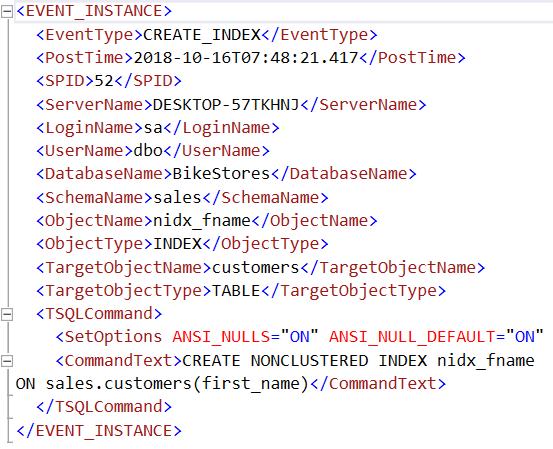Summary: in this tutorial, you will learn how to use the SQL Server data definition language (DDL) trigger to monitor the changes made to the database objects.
Introduction to SQL Server DDL triggers
SQL Server DDL triggers respond to server or database events rather than to table data modifications. These events created by the Transact-SQL statement that normally starts with one of the following keywords CREATE, ALTER, DROP, GRANT, DENY, REVOKE, or UPDATE STATISTICS.
For example, you can write a DDL trigger to log whenever a user issues a CREATE TABLE or ALTER TABLE statement.
The DDL triggers are useful in the following cases:
- Record changes in the database schema.
- Prevent some specific changes to the database schema.
- Respond to a change in the database schema.
The following shows the syntax of creating a DDL trigger:
CREATE TRIGGER trigger_name
ON { DATABASE | ALL SERVER}
[WITH ddl_trigger_option]
FOR {event_type | event_group }
AS {sql_statement}
Code language: SQL (Structured Query Language) (sql)trigger_name
Specify the user-defined name of trigger after the CREATE TRIGGER keywords. Note that you don’t have to specify a schema for a DDL trigger because it isn’t related to an actual database table or view.
DATABASE | ALL SERVER
Use DATABASE if the trigger respond to database-scoped events or ALL SERVER if the trigger responds to the server-scoped events.
ddl_trigger_option
The ddl_trigger_option specifies ENCRYPTION and/or EXECUTE AS clause. ENCRYPTION encrypts the definition of the trigger. EXECUTE AS defines the security context under which the trigger is executed.
event_type | event_group
The event_type indicates a DDL event that causes the trigger to fire e.g., CREATE_TABLE, ALTER_TABLE, etc.
The event_group is a group of event_type event such as DDL_TABLE_EVENTS.
A trigger can subscribe to one or more events or groups of events.
Creating a SQL Server DDL trigger example
Suppose you want to capture all the modifications made to the database index so that you can better monitor the performance of the database server which relates to these index changes.
First, create a new table named index_logs to log the index changes:
CREATE TABLE index_logs (
log_id INT IDENTITY PRIMARY KEY,
event_data XML NOT NULL,
changed_by SYSNAME NOT NULL
);
GO
Code language: SQL (Structured Query Language) (sql)Next, create a DDL trigger to track index changes and insert events data into the index_logs table:
CREATE TRIGGER trg_index_changes
ON DATABASE
FOR
CREATE_INDEX,
ALTER_INDEX,
DROP_INDEX
AS
BEGIN
SET NOCOUNT ON;
INSERT INTO index_logs (
event_data,
changed_by
)
VALUES (
EVENTDATA(),
USER
);
END;
GO
Code language: SQL (Structured Query Language) (sql)In the body of the trigger, we used the EVENTDATA() function that returns the information about server or database events. The function is only available inside DDL or logon trigger.
Then, create indexes for the first_name and last_name columns of the sales.customers table:
CREATE NONCLUSTERED INDEX nidx_fname
ON sales.customers(first_name);
GO
CREATE NONCLUSTERED INDEX nidx_lname
ON sales.customers(last_name);
GO
Code language: SQL (Structured Query Language) (sql)After that, query data from the index_changes table to check whether the index creation event was captured by the trigger properly:
SELECT
*
FROM
index_logs;
Code language: SQL (Structured Query Language) (sql)Here is the output:

If you click on the cell of the event_data column, you can view XML data of the event as follows:

In this tutorial, you have learned how to create a SQL Server DDL trigger that responds to one or more DDL events.